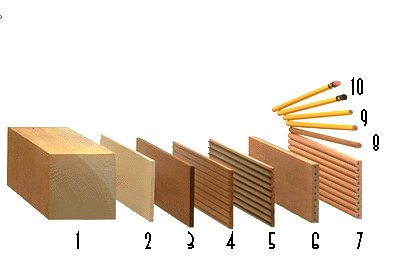The secret of pencil life, the invention of pencil
The invention of the pencil
In 1564, a strong wind blew down a large tree near the Polo Valley in Cumberland, England, and a lot of ink-colored minerals-graphite, were exposed at the root of the tree. The local shepherd discovered one use of graphite-drawing marks on the sheep. Soon, discerning city people cut graphite ore into thin strips and sold them on the London market. Both shopkeepers and merchants used it to mark goods, so it was called "printing stone". This "original pencil" draws thick and black marks.
However, graphite is fragile. In 1761, the German chemist Faber collected some graphite ore from the Castasell coal mine, grinded it into a powder, washed it with water to remove impurities, and obtained pure graphite powder. After various tests, Faber finally found that in Graphite is mixed with sulfur, antimony and resin, heated and solidified, and pressed into a "pencil". The hardness is suitable, the writing is smooth, and it is not easy to stain your hands. After wrapping this paper with a paper roll, you can take it Sold to the store.

In 1789, the French Revolution broke out, Britain and Germany blocked France, and there was no source of pencils. The impact on France was not small. French chemist and inventor Conte was instructed to collect graphite in France to make pencils as much as possible, but French graphite The quality is poor and the output is not much. Conte tried hard and finally had an idea. Some graphite experiments were mixed with graphite. The effect was unexpectedly good. This mixture became the best brush in the world. Adding different properties of clay can get "hard lead" and "soft lead".
However, both Conte's pencil and Faber's pencil have only a thin strip, which is easy to break. In 1812, William Monroe, a carpenter and tinker in Massachusetts, became a popular figure. He was determined to add icing to the pencils and put the pencils on the wood "coat". Monroe installed machinery in the soil field to manufacture standardized wooden strips with a length of 5-18 cm. The middle of the thin wooden strips was dug with a machine to fit a groove just for the pencil core, and then two thin wooden strips with the same grooves were opened in the middle. A graphite strip is embedded and glued together with glue. Thus, the first modern pencil was born. This 18-centimeter-long standard pencil can draw 55 kilometers of lines, at least 45,000 words can be written, and it has been cut 17 times, leaving a 5-centimeter-long pen.
One hundred years after the birth of the Monroe pencil, some people thought it wasted wood, and as a result, the Japanese Tokugawa Hayakawa invented a pencil that can repeatedly push the pencil core in 1915, which is the prototype of the widely used movable pencil . The world of more than 300 pencils is dazzling.
China Pencil Trading Network is an e-commerce platform under the China Net Library that focuses on pencil wholesale, pencil procurement, pencil investment, and pencil franchise. It gathers all upstream and downstream enterprises across the country for genuine procurement and genuine wholesale. Provide consumers with a professional pencil trading platform and information, with rich pencil resources. Fundamentally, the quality of the pencil can be guaranteed. So if you want to pay more attention to pencil information, please go to China Pencil Exchange.








